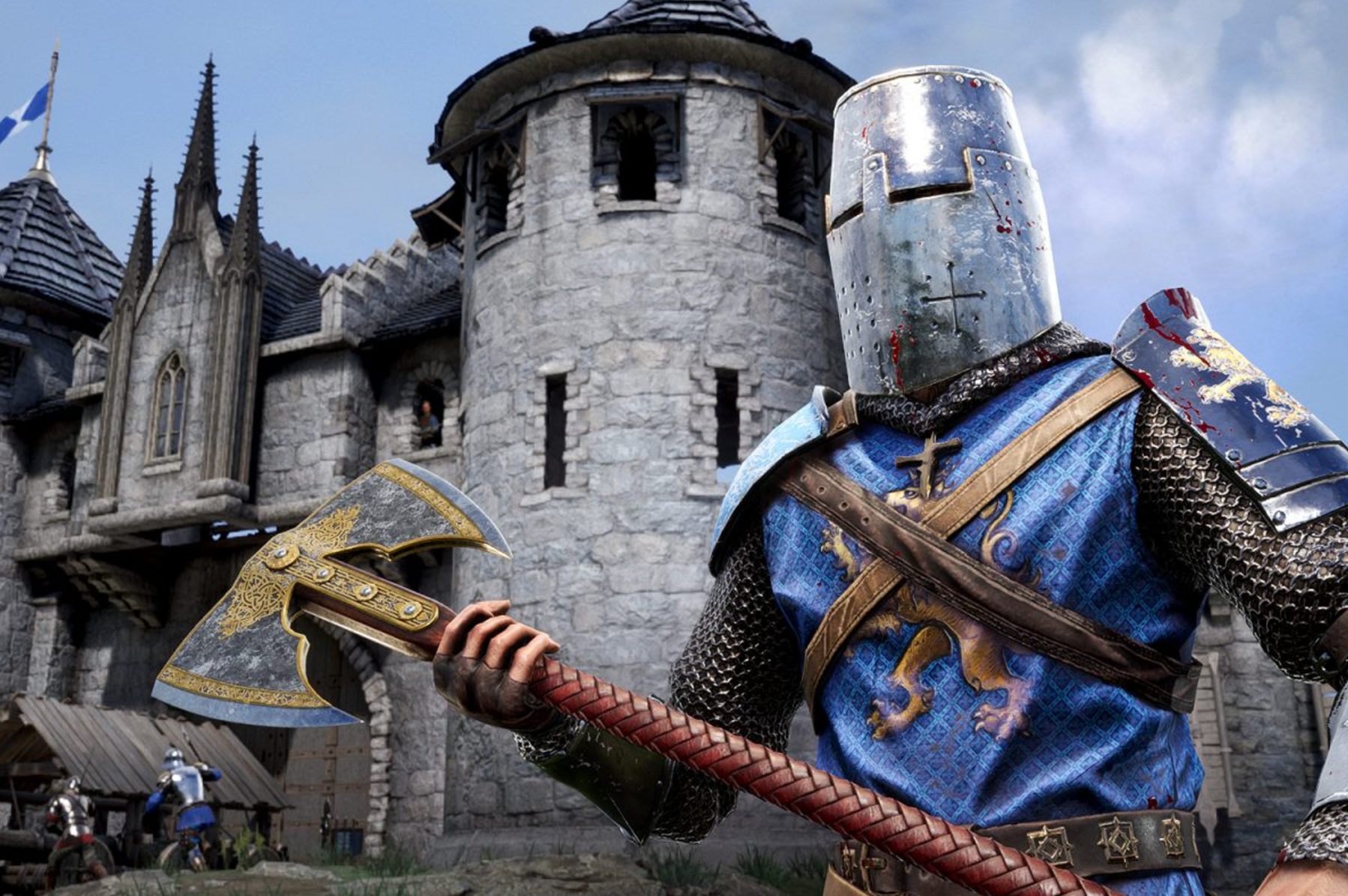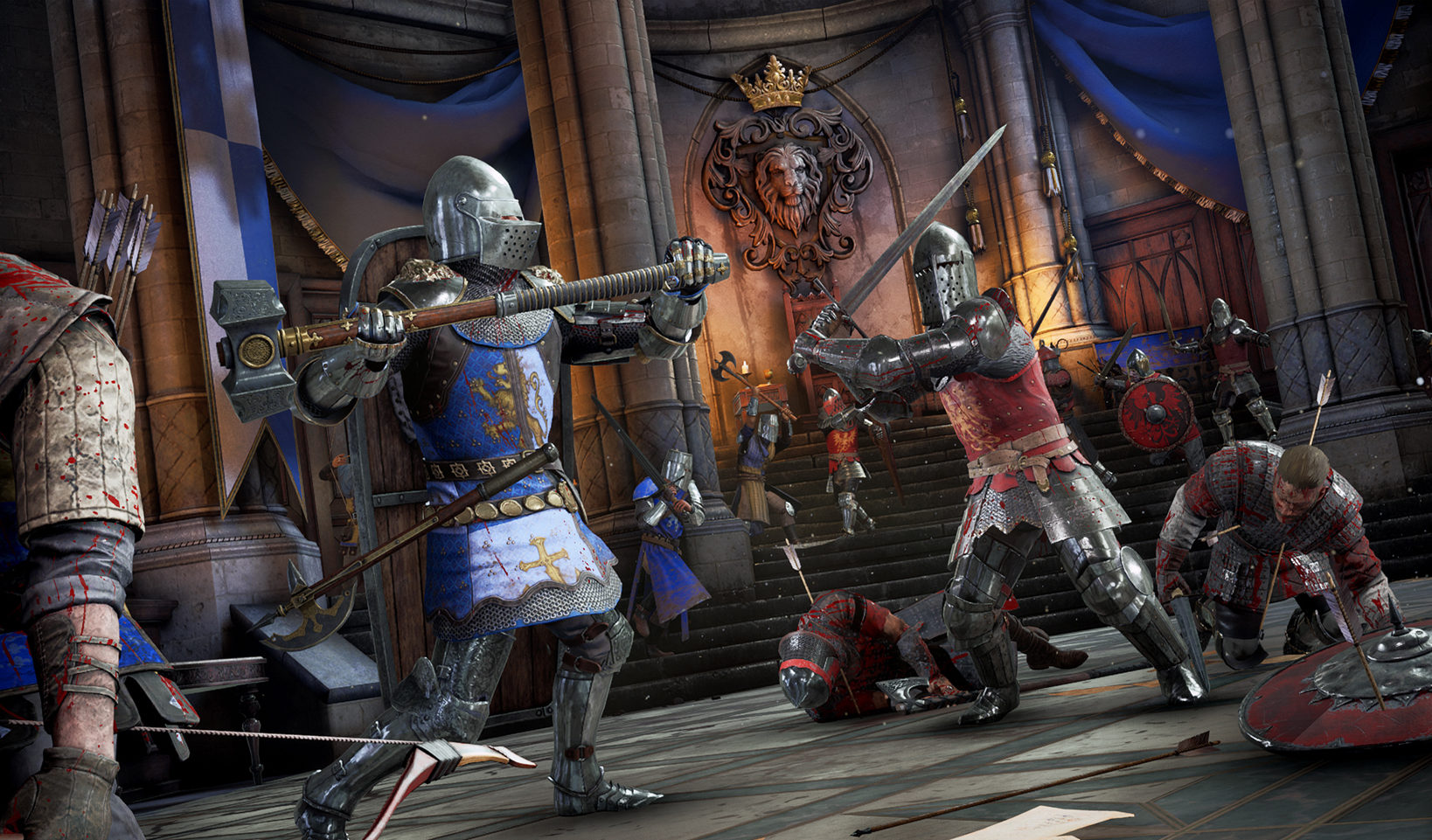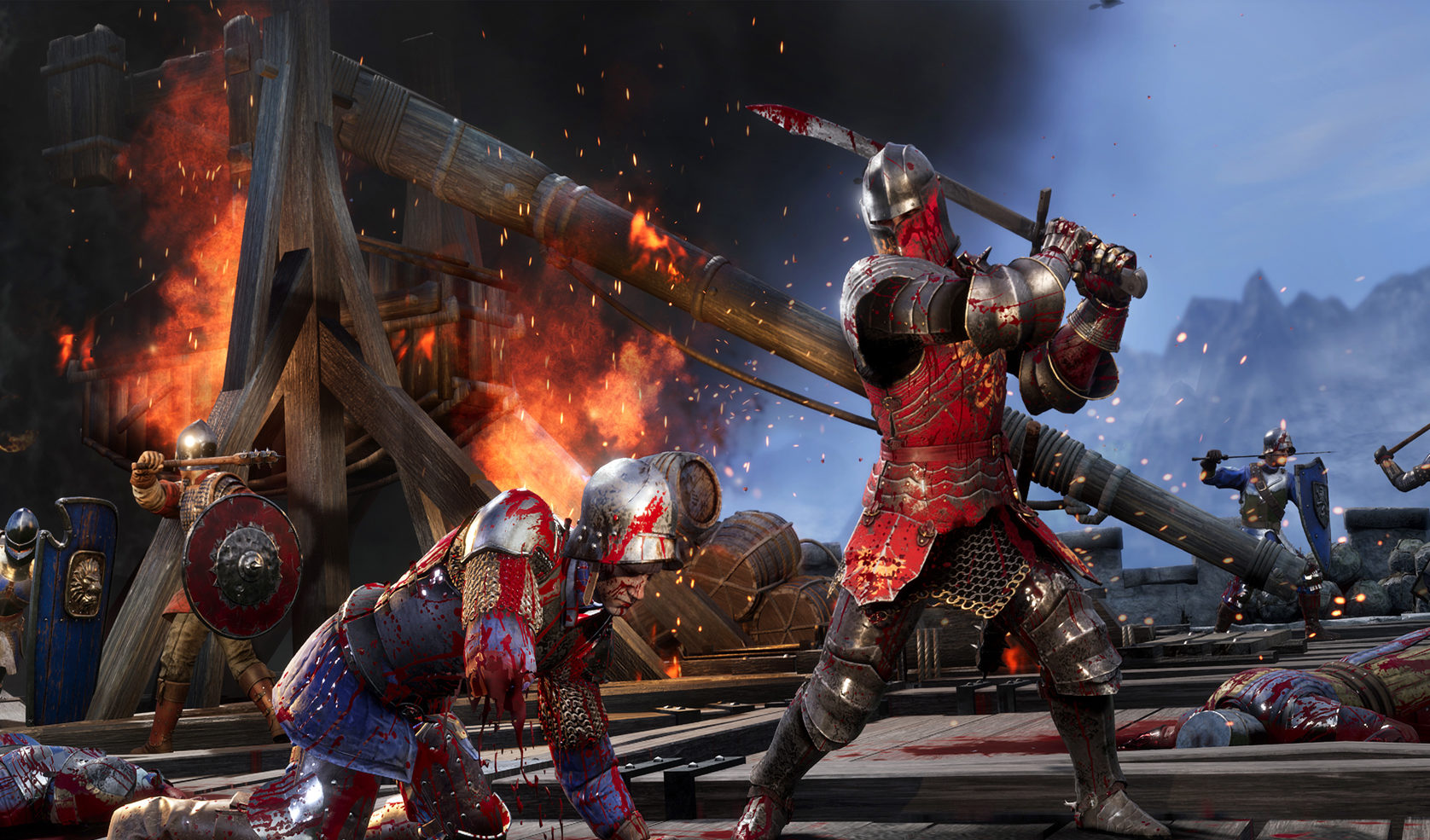Platforms:
Xbox One, PS4, PC, PS5, Xbox Series X|S
Released:
June 8, 2021
Publisher:
Tripwire Interactive
Developer:
Torn Banner Studios
I don’t know if I’m just a bit of a hermit, but it’s rare that I actually sink my teeth into an exclusively multiplayer experience. Sure, some of it is just not wanting to deal with toxic people in chat. However, some of it comes down to the feeling that multiplayer tends to sacrifice the individual experience in favour of larger servers. Chivalry 2 shows that you can have both mechanical complexity and large servers, though it is not without some frustrations.
Chivalry 2 is a first or third-person melee combat game on a large scale. The Chivalry name started way back in 2007 as a Half-Life 2 mod but ended up being a catalyst for many a medieval warfare game moving forward including the more recent Mordhau. Players will collide on a large battlefield, often in two teams, with swords clashing and arrow flying all around.
Weapons of mace destruction
I suppose the best place to start dissecting Chivalry 2 is the mechanics themselves. There is quite an extensive tutorial. It belies how intricate all the systems at play are.
When you’re mostly using melee weapons here: swords, clubs, polearms, and the like. You have horizontal slashes, overhead swings, and a forward stab. On the defensive side of things, you can maintain a defensive stance that uses up stamina, or dodge around enemies to avoid attacks, or make new angles to attack past defences. You can throw weapons, pick up weapons off the dead, you can be an archer or jump on a ballista or catapult for some projectile attacks. The point is there are a lot of little ways to get your hands bloody. There’s a good amount of variety to ensure that you can find a loadout that works for you. Even then, there are enough details that facilitate a variety of strategies to help you push any little advantage.
“There is a logical, calculating art of death that runs red through the veins of this game.”
There is also an impressive balance to the defense. The basic version is simply holding the right mouse button to defend against head-on attacks. You can hold this button down as long as you want to keep your guard up, but doing so depletes your limited stamina which you’ll want to hold onto for dodging. Dodging pulls double duty as both an evasive maneuver and as a means to sneak past an enemy’s defensive stance. As one may expect, there are also parrying systems, focused on making attacks immediately after blocks. The last few moves, such as kicking and jabbing, follow more of a “the best defence is a good offence” style of logic. They act as counters to stop attackers from stacking multiple slashes in a row.
The two sides of the coin in attack and defense, and the different classes, contribute to a well-rounded and dramatic fighting system. In the grand scheme of things, I’d say it’s a well-conceived system. Central pillars of timing, positional advantage, and keeping the opponent on the back foot come to mind. There is a logical, calculating art of death that runs red through the veins of this game. It’s beautiful in a sense. While it can be a bit of an intimidating thing to step into, the tutorial does a very impressive job. It’s not only teaching the basics of hitting things and defending. Players also learn to keep the upper hand when you have it and how to block or to evade damage when you do not. I’ll put my hand up and say that it didn’t fully sink in the first time. I did a few rounds, and when I couldn’t get a game for a moment, I tried out the tutorial again. It genuinely helped to see some of those lessons a second time over. If nothing else, the third-person mode helped me process the bloody mess that I seemed to be constantly walking into.

Duking it out
There’s such a beautiful system set up for fighting in Chivalry 2, yet the entire game is in multiplayer. Woe is me, such beautiful art put into the hands of the unwashed masses. I jest of course. However, in the grand scheme of things, the worst parts of the game come out of the multiplayer. Unfortunately, it is also paradoxically the best part. Also, they are literally the same parts. Just stick with it, it’ll make sense. There are really two flavours of game modes in Chivalry, team and free-for-all.
“It’s noteworthy that Agatha V Mason maps demonstrate cleanly the Red Oni, Blue Oni trope that has become a bit of a gaming cliché as of late.”
If the main menu is anything to go by, team mode is considered the one that belongs centre stage. At the end of the tutorial, you are asked to pick one of the two warring factions. The Mason order in the red and black stands for dominance over the weak. The Agatha Knights are in blue and white, standing for duty and honour, believing themselves to be entitled to the throne. I’ll say right now that, meaning no disrespect to the game’s writers, this decision is not really worth considering. It’s noteworthy that Agatha V Mason maps demonstrate cleanly the Red Oni, Blue Oni trope that has become a bit of a gaming cliché as of late. Basically, it boils down to “passionate and defiant group vs. controlling authority group”. There are so many games that have this dichotomy and it’s starting to feel a little stale.
The only real reason for factions is to sell the team modes. Each of the multiplayer games begins with some kind of narrative being tossed out. These fights get fancy names like “The Slaughter of Coxwell” and characters will get shouted at about dying for your cause, all to instil a sense of narrative into the future massacre. It fits that the majority of these modes are “Team Objective” modes. It will ring familiar to many players. Objectives will require attacking teams to push payloads, clear obstructions to a payload, open gates by force, control areas, kill targets in an allotted time, and more. Defending teams merely have to hold the position and prevent the attacking team’s encroachment.

The other team game mode is far more straightforward, a deathmatch. Each team has a limited amount of respawns and you win by eliminating all the opposing team’s lives. It’s worth mentioning that this mirrors the non-team mode, free-for-all. It’s the same maps, just with no affiliation, all death to all people all the time. Both deathmatch modes are rather instructive in explaining how teams affect a game like this.
I alluded to the multiplayer being both the best and worst thing that Chivalry 2 has to offer. Well, let’s zero in on that one thought. The best and worst thing about Chivalry 2 is the manic chaos of its gameplay in an online environment.
The Arms of Chaos
Chaos really shouldn’t be a surprise if we’re being honest. This is a game where you can slash wildly enough to hit 4 or more people at once. You are, theoretically at least, playing with either 39 or 63 other real players. The battlefield, on occasion, resembles a beehive. It is madness. The specific flavour of madness varies between team and free-for-all modes.
On the positive side, the team modes feel like they’re more predictable and organised. The Objective tasks are about holding the line. There’s a split between the factions, there’s a frontline, and you must push your team forward, or prevent the opposition’s advances. It also lends itself to co-operation. Multiple teammates can work together to surround and destroy an opponent. Conversely, there can be these epic moments of fending off multiple attackers. When hope is almost run out, you are saved by well-timed reinforcements. With this predictability comes larger-scale planning. There can be choke points, flanking, and all manner of strategy to make your push. This, however, is not an infinite resource. These are all zoomed-out views of the battlefield, when you are actually a soldier, it can be less straightforward.
“The battlefield, on occasion, resembles a beehive. It is madness.”
So let’s jump back to that topic of chaos. There are 40 and 64 player servers. Some maps, particularly those in deathmatches, are small. Even the large objective maps use “return to battlefield” mechanics to keep the combatants in close proximity and chokepoints. Add these two elements to the long attack wind-ups and friendly damage, and you have everything you need to make sure that little “team damage” subtitle earns its salary. For example, I see an opponent, I get a nice heavy swing going, and a teammate barges in front and tanks all the damage. The horizontal slash, prized for its ability to sweep through multiple targets, frequently becomes a liability. Over time I narrowed my offensive capabilities. No slashing, no overheads, stabs only. This became the go-to attack. Stabs seemed like the smallest risk of friendly fire. Over the course of the two dozen or so campaigns I played, I killed and was killed by members of my own team multiple times. Funnily enough, it undercuts the whole “team effort” thing when your own team is clubbing you to death.
I will also say, the game isn’t the best at making some information visible. Usually, it was easy to tell who was on what team on the battlefield. However, the cosmetics at times undermined this effort. Some Agatha skins have minimal visible blue attire, and the same is true of red on select Mason skins. The other problem is the blood effects. Aesthetically the blood is a nice choice. It can help get a read on who are the injured characters, so it helps in-game as well. There’s just a little problem. We have a red team fighting a blue team. Covering a character in red indiscriminate of affiliation throws a spanner in the works. It’s an unwarranted critique you may think, but that lapse in concentration as you determine friend from foe can be a real disadvantage.

The free-for-all deathmatch doesn’t run into the same problems as other modes because there are no teams to concern yourself about. It is definitely a much more free, less paranoid kind of experience. The rules are simple: if you see someone that isn’t dead, correct the issue. No worries about splash damage either, that’s an advantage here. Although one thing to consider is that it’s pretty hard to get on a leaderboard as a solo act. If I were to guess, this is in part due to solo vs team play, but I would also guess that higher-tier players might be jumping on this mode. This exacerbates the source of free-for-all’s chaotic vibe.
The issue with free-for-all is that it is unbridled chaos. The whole “battlefield as a beehive” issue only becomes worse when you have no line to hold. You will run to an enemy, draw your sword back for a clean decapitation, before being bonked by some random from stage right. That’s what it comes down to when we talk about chaos in this mode. Whether this critique comes across as whiny may be a product of whether you do well or not. And, to a degree, your success feels like it’s in the winds of fate. Chaos may grant you a single slash that kills one and maims another. Other times you’ll walk around for ten seconds looking for a fight and get killed without being able to see who did you in. In some cases I spawned in a high location, fell, landed on spikes, and died instantaneously.
The chaos is my primary issue with Chivalry 2, and perhaps with online multiplayer games as a whole. When death can come at any moment, regardless of context. And when you can expect to die on occasion at a teammate’s hand, or from outside your camera view, it’s hard to get a sense of fairness. That’s the nature of chaotic gameplay. When you’re winning the chaos fuels the revelry of destroying an enemy. When you’re losing, it’s a ridiculous farce with no inherent rational consistency to make it feel like more than a throw of the dice. Whether this becomes part of the game’s charm or a frustrating element of gameplay will differ on a player by player basis.
8
Great
Positive:
- Good variety of attacks and offensive capabilities
- Defensive mechanics give a variety of options
- Tutorial runs gamut from basic moves to multi-step evasive manoeuvres
Negative:
- Games can be a bit of a chaotic mess
- Cosmetics and blood effects can obscure team colours
As is the case with many good multiplayer games, the game itself is well made, but mileage may vary with your actual experience playing it. Mechanically, I was impressed with the depth and breadth of everything that you get to play with. Combat itself is incredibly detailed, and the capabilities to have such a compelling game in a crowd of warring factions is impressive. However, the chaos of the battlefield may be a dealbreaker for you; you may find it compelling, or you may find it frustrating. At best I can say it is part of Chivalry 2’s charm, but I’m not able to say that I always appreciated it. Regardless, the specific flavour of madness it provides makes for a fun, violent time, even amongst the varying degrees of chaos.





